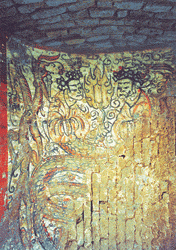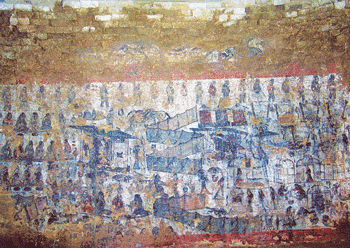Murals Reveal Aristocrats' Lives 1,500 Years Ago
|
Some well-preserved murals have been discovered in a tomb of more than 1,500 years old in Datong, North China's Shanxi Province, supplying rich first-hand evidence for the research of early ethnic apparel and rituals. The tomb was identified to belong to a general's mother who died in AD 435. Taking up an area of 24 square meters, it was found in a cemetery of 12 tombs excavated last summer by local archaeologists. Lying on a plateau in the rural suburbs of Datong, the cemetery dates back to the Northern Wei Dynasty (AD 386-534). The murals were painted in red, black and blue on all the four walls of the tomb and its pathway. Murals on the northern wall are divided into two parts by a horizontal red line, said Liu Junxi, a local archaeologist who led the excavation. The upper part depicts six exotic animals with each symbolizing a constellation; while the lower part contains seven rows of pictures.
The first row portrays 19 well-dressed women. Under it is a huge picture of an ancient ceremonious outing: A number of riders, musicians and soldiers carrying streamers and lances are surrounding a canopied carriage, in which sits a man. Although most of the murals feature women on the eastern wall, a big building dominated one at its lower centre. Inside the building are a couple, probably the tomb owners, sitting up straight. Both of them wear big black hats, indicating they were minorities. A total of 34 male images have been found on both the eastern wall and the southern wall. Meanwhile, the latter also has a big banquet scene, involving various wine vessels, food, carriages and instrumentalists. Two scenes of baking and brewing are painted on this wall, too. In the rest of the murals, archaeologists saw pictures of soldiers wearing helmets and armour, and some fairies. "The soldiers are all in pairs, either in red clothes or armour, holding swords in one hand and shields in the other," Liu described. Compared with the faces of the soldiers, fairies in the mural look more amiable. They are half human and half dragon with garlands on their heads, flying on the wall of the tomb pathway. Ancient artists outlined partial pictures of these murals with red lines first, then sketched out the entire picture with black lines, and finally filled in paints, according to Liu. She said the murals could be reflections of real life at that time, or an expression of the deceased's expectation for future life.
"The tomb murals we found are unique in all excavated tombs of that historical period," Liu added. Archaeologists also unearthed scads of color lacquer remains in the tomb. On the remains are paintings of the couple's everyday activities, including cooking. "We also found inscriptions on a piece of lacquer remains, from which we conclude that the female tomb owner was the mother of a high-class officer," Liu added. Now Liu and her colleagues are duplicating these murals and planning further protection efforts.
|



